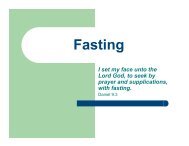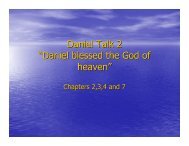Handout - Western Christadelphian Bible School
Handout - Western Christadelphian Bible School
Handout - Western Christadelphian Bible School
Create successful ePaper yourself
Turn your PDF publications into a flip-book with our unique Google optimized e-Paper software.
Session 1: Learning From The Word<br />
Deciding whether a <strong>Bible</strong> teaching is a “fundamental” is not always easy. Sometimes<br />
subjective elements creep into our discussions. What appears absolutely vital to one may be<br />
less so to another. Settling these differences can be a vexing business.<br />
It is helpful to have tools for deciding the significance of a particular idea being considered.<br />
One such tool is to know how a conclusion has been reached. Then the importance of the<br />
conclusion can be assessed in terms of the strength - or weakness - of the method used in<br />
arriving at it. In this discussion we’ll review the methods used to arrive at conclusions from<br />
scripture and then attempt to rate them according to their “reliability”.<br />
To most of us, the “reliability” of an idea drawn from scripture is beyond question. But<br />
while scripture itself has an exact meaning, our ability correctly to understand that meaning<br />
is sometimes faulty. Hence the need to assess the limits of validity of a conclusion. To<br />
illustrate:<br />
0 1 2 3 4 5 6 7 8 9 10 11 12<br />
Ruler A<br />
Object Being Measured<br />
11 + -<br />
1<br />
4 Units<br />
11 +<br />
- 1 Units<br />
2<br />
0 1 2 3 4 5 6 7 8 9 10 11 12<br />
Ruler B<br />
1 Both rulers give the object's length as being nearest to 11 Units.<br />
1<br />
2 Ruler A tells us that the length is closer to 11 Units than it is to 10 or 111<br />
.<br />
2 2<br />
3 Ruler B tells us that the length is closer to 11 Units than it is to 10 or 12.<br />
4 Ruler A is a better instrument than Ruler B because there is less uncertainty<br />
associated with its reading.<br />
The reader may wonder what this has to do with the <strong>Bible</strong>. The answer is that learning<br />
anything from the <strong>Bible</strong>, even fundamentals, involves a process that is somewhat like taking<br />
measurements. If we use an “accurate ruler” we are entitled to draw conclusions that carry a<br />
correspondingly small range of uncertainty. If we can only use a “rough guide” our result<br />
will be more uncertain. In the first case our conclusions will demand greater respect as<br />
“fundamental” than in the second.<br />
There seem to be only four methods used in learning from the <strong>Bible</strong>. Each will be discussed<br />
in turn, with examples; and then an attempt will be made to assess the uncertainty associated<br />
with conclusions drawn by use of each.<br />
Page 7







